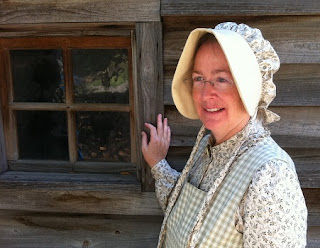I'm back to working on a Mosaicon that's been languishing for months - the icon based on the image of Diana the Huntress. You first met it in my blog post back in September. The Leonardo da Vinci icon pushed its way to the fore and the Dia de los Muertos icon bounced in and demanded to be finished. Diana waited. Fortunately, she seems to be willing to wait for me. I'm grateful!
The June 2011 collection from Gecko Galz contained a set of Grecian Girls images. One of the images seemed especially appropriate for the Huntress icon. I decided to use that image transferred to a polymer clay tile. I thought it might be appropriate to share the technique for image transfers here. Or at least one technique! There are many.
Choose Your Image
Choosing your image might not sound like a big deal, but it really is. You don't want it so busy that little details will be lost in the transfer process. There also needs to be a strong focus in the image. In fact, the strong focus is what you will transfer. Backgrounds need to be merged into the tile itself, usually with paint. You will probably need to size your image, possibly crop it, and most likely need to reverse the image, all of which can be done in Paint, but I prefer Photoshop Elements. Bear in mind that the image will transfer reversed from how it is printed, so plan accordingly. This is extremely important if there are words or if the image is so well-known that seeing it reversed will cause problems.
Once you've chosen your image and cropped and reversed it, make a page with several sizes of the image. You're pretty sure what size you want the finished tile to be, but I'm always grateful to have several choices of image sizes to choose from. For this technique, print the finished page of images on an inkjet printer. I print them on matte brochure or presentation paper. You want a good enough paper to get a good ink saturation, but you don't want a glossy photo finish. After the ink dries, tear out the image you want to use.
Preparing the Polymer Clay Tile
There are several types of clay you can use to make your tile. I recommend using either Sculpey white clay or Premo white or pearl clay. The clay color will show through the image, somewhat, and will affect the finished image. The whiter the clay, the less it will interfere with the color of the image inks. In the following photos, I've used Premo pearl clay.
Prepare and bake several sizes of tiles. Having several sizes ready to go makes it easier if you change your mind about the finished product, or make a mistake that can't be recovered.
Gather Your Materials
 |
| Materials |
For this technique, you'll need the image, the baked and cooled tile and a gel medium. I use Liquitex gloss gel medium. It's useful to have some kind of burnishing tool. A good old-fashioned Popsicle stick works beautifully! Having a box of baby wipes and paper towels on-hand helps with keeping the mess at bay.
"Gluing on the Image"
Coat the image with the gel medium and place it, coated image side down, on the polymer clay tile. With your burnishing tool, burnish the image onto the tile, making sure the ink of the image is in contact with the tile and that there are no air bubbles. Do NOT start removing the paper backing yet! You'll be almost certain to tear the delicate ink film if you do.
Remove the Paper Backing
 |
| Removing the Paper |
 |
| Image Appearing Through The Haze |
 |
| Image Appearing |
 |
| Transfer Completed! |
 |
| Finished Painted Tile |
Once you have the image transferred and the rest of the tile painted, you might think you're finished. Do remember to seal the tile! The image will be delicate and can easily be scratched, especially if you're using the tile as a piece of jewelry. You'll want to seal it with an acrylic sealer once the paint dries. Apply several coats to adequately seal the image and paint.
And always remember the most important thing:
ENJOY!!







